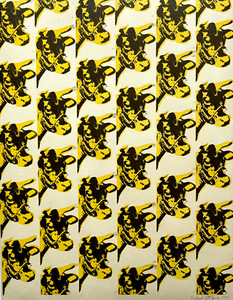
Andy Warhol
Neon light Cow Wall Display Sign, 2022
Acrylic-printed cow lined with red neon LED artwork with energy-efficient tubing, full board backing
ACCOMPANIED BY A NUMBERED CERTIFICATE OF AUTHENTICITY AUTHORIZED BY THE WARHOL FOUNDATION
24 × 14 1/2 × 1/2 inches
LIMITED EDITION OF 500. ACCOMPANIED BY A NUMBERED CERTIFICATE OF AUTHENTICITY AUTHORIZED BY THE WARHOL FOUNDATION.
In 1966, Andy Warhol officially took an artistic stand against traditional painting. The iconic Cow portrait is a direct result of this, and the result is an explosively-colorful portrait! Warhol said, "I never met an animal I didn't like."
In this neon cow, the original image is lined with yellow and hot pink neon, bringing the already expressive art to glowing life! This playful and experimental LED neon sign is perfect for taking your space from basic to brilliant.
The flexible LED tube is safe and environmentally friendly, too! Set the light to the time of day with adjustable brightness.
©/®/™ The Andy Warhol Foundation for the Visual Arts, Inc.
It is made of a neon flex material, consisting of PVC or Silicon piping with LED lights, that is mounted on a recycled acrylic board, creating a realistic neon sign, with bright lights and intense color, while being more durable, affordable, and sustainable than traditional neon.
The flexible LED tube is safe and environmentally friendly, too! Set the light to the time of day with adjustable brightness.
©/®/™ The Andy Warhol Foundation for the Visual Arts, Inc.
Size: 24 x 14.5 in (60 x 37 cm)
Colors: Yellow & pink
Designed to shine
LED neon artwork
Energy-efficient tubing
Full board backing
Shipped in a bespoke premium box
Materials include:
LED lights: consuming 6 times less energy than traditional lights, they last up to 80,000 hours.
recycled materials in our products
and 100% recycled packaging, including removing all useless plastic.
Energy efficient tubing. Shipped in bespoke premium box with Warhol's authorized printed signature
About Andy Warhol:
Isn’t life a series of images that change as they repeat themselves?
—Andy Warhol
Andy Warhol’s (1928–1987) art encapsulates the 1960s through the 1980s in New York. By imitating the familiar aesthetics of mass media, advertising, and celebrity culture, Warhol blurred the boundaries between his work and the world that inspired it, producing images that have become as pervasive as their sources.
Warhol grew up in a working-class suburb of Pittsburgh. His parents were Slovak immigrants, and he was the only member of his family to attend college. He entered the Carnegie Institute of Technology (now Carnegie Mellon University) in 1945, where he majored in pictorial design. After graduation, he moved to New York with fellow student Philip Pearlstein and found steady work as a commercial illustrator at several magazines, including Vogue, Harper’s Bazaar, and the New Yorker. Throughout the 1950s Warhol enjoyed a successful career as a commercial artist, winning several commendations from the Art Directors Club and the American Institute of Graphic Arts. He had his first solo exhibition at the Hugo Gallery in 1952, showing drawings based on the writings of Truman Capote; three years later his work was included in a group show at the Museum of Modern Art for the first time.
The year 1960 marked a turning point in Warhol’s prolific career. He painted his first works based on comics and advertisements, enlarging and transferring the source images onto canvas using a projector. In 1961 Warhol showed these hand-painted works, including Little King (1961) and Saturday’s Popeye (1961), in a window display at the department store Bonwit Teller; in 1962 he painted his famous Campbell’s Soup Cans, thirty-two separate canvases, each depicting a canned soup of a different flavor. Soon after, Warhol began to borrow not only the subject matter of printed media, but the technology as well. Incorporating the silkscreen technique, he created grids of stamps, Coca-Cola bottles, shipping and handling labels, dollar bills, coffee labels, and more, breaking down the images to their basic graphic components.
In 1963 Warhol established a studio on East 47th Street, which became known as the Factory and served as a cultural hub for artists, models, performers, and socialites. His inner circle comprised his Superstars, who played a major role in both his work and his social life. Interested in the production of fame, Warhol began to screen-print images of celebrities and public figures, from Marilyn Monroe and Elvis Presley to Jackie Kennedy and Mao Zedong. Expanding his practice, as well as his cultural influence, he produced records (The Velvet Underground & Nico), started a magazine (Interview), and made avant-garde films, such as Chelsea Girls (1966), Blow Job (1964), and Empire (1964), which have become classics of the underground genre.
Following a close run-in with death when Valerie Solanas shot him in 1968, Warhol entered a more subdued, isolated period, working primarily on a commissioned basis and painting portraits for various patrons, while also revisiting themes from his earlier work. He then began to pursue a new interest in abstraction, first with his Oxidations (1977–78), made by allowing friends and acquaintances to urinate on canvases painted with metallic pigments, and later with his Rorschach (1984) and Camouflage (1986) paintings.
By the early 1980s Warhol was producing work across media with a renewed vigor, hosting half-hour programs on MTV, publishing books, and collaborating with younger artists including Jean-Michel Basquiat, Francesco Clemente, and Keith Haring. His abstract series coincided with large-scale works that looked back at masterpieces by Leonardo da Vinci: he screen-printed images of the Mona Lisa (1503) and created several monumental canvases of The Last Supper (1495–98). Warhol’s ability to seamlessly combine art historical reference, abstract patterns, and mass media set new standards for the role of the artist, permanently blurring the lines between commercial and fine art.
Courtesy of Gagosian








